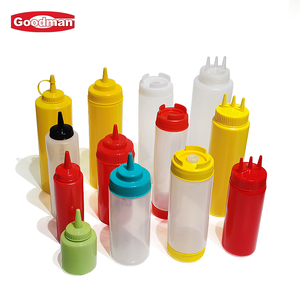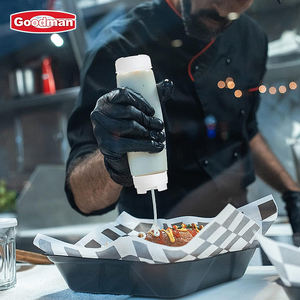
All categories
Featured selections
Trade Assurance
Buyer Central
Help Center
Get the app
Become a supplier

(1827 products available)













































Glass Salsa Bottles
Many customers choose glass salsa bottles because they are a classic and environmentally friendly option. Because they are impermeable, glass containers keep salsa fresh by stopping air from entering. Customers appreciate the sophisticated and polished appearance of glass bottles, which enhances the salsa's appeal. They offer a longer shelf life for goods that need special handling, such as refrigerated or perishable items, and work well for specialty and premium salsa brands. Glass bottles frequently have plastic or metal lids that offer additional sealing and reuse possibilities. For manufacturers, the aesthetic appeal and recyclability of glass containers make this material a sustainable packaging choice.
Plastic Salsa Bottles
The bottles are a very adaptable choice for transporting and selling salsa since they are lightweight and unbreakable. Salsa intended for greater distribution can be packaged in plastic bottles, especially in the food service industry and for wholesale sales. The design of the bottles may be gradient with the brand's design, which aids in creating an identity. Plastic bottles are more practical than glass for certain settings and customers, even if they are often less recyclable. Large plastic containers for commercial use and smaller retail-sized containers are among the volume and sizes available for plastic bottles. For operations that put the first product's safety and logistics above environmental issues, plastic is a practical choice.
Metal Salsa Bottles
Although not as popular as glass or plastic, metal containers, such as stainless steel, are emerging for niche markets. These bottles are extremely durable, waterproof, and fit for transporting hot or cold salsa. Due to their toughness, they are appropriate for outdoor activities or circumstances in which glass or plastic may fracture easily. Since stainless steel is recyclable and less harmful than certain other materials, it could be a more environmentally friendly option. This kind of packing is uncommon for retail but may be found in specialty uses or for private labels that provide premium goods.
Squeeze Bottles for Salsa
The bottles are perfect for thinner salsas or those needing more convenience in dispensing, such as salsa roja or pico de gallo. As mentioned, these plastic squeeze bottles allow efficient control over how much salsa is released, preventing spills and messes. They are a preferred packaging choice for restaurants and food trucks because they are easy to refill and clean. Practically, the squeeze bottles are useful for both retail and food service operations, especially in situations that require quick and efficient service. With branding printed directly on the bottle, vertical packaging offers a practical option and an extra branding space for businesses.
The look at the salsa bottles is critical for brand recognition and consumer appeal. A well-designed bottle can improve the product's aesthetic value and increase sales. The design of salsa bottles entails the following:
Labeling and Branding
Strong branding is crucial because it sets a company apart from its rivals on shop shelves. The logo, color palette, and general design theme should express the salsa's heritage, flavor profiles, and target market. Typography must be chosen carefully to exude the spirit of the item, whether contemporary, traditional, or rustic. Clear labeling of ingredients, nutritional information, and other crucial details is necessary to comply with legal requirements and consumer expectations. A catchy slogan or descriptive text that details the salsa's flavor and intended use may enhance the label's appeal.
Shape and Size
The bottle's form affects how customers perceive it and its usability. Traditional cylindrical containers are familiar and simple to stack, but certain brands may use distinctive shapes to increase recognition of their products. When performing market research, consider how the form fits into a customer's hand; this can be significant. Various sizes also serve different markets; bigger bottles are ideal for the wholesale or food service industries, while smaller retail-packaged goods are intended for individual customers.
Closure Systems
The salsa bottle's closure plays a significant role in maintaining product quality and usability. Regular jar lids are one of the more typical closure styles for glass bottles since they enable simple refilling and sealing. Plastic flip tops or squeezy caps provide greater ease of use for liquid salsas, enabling controlled pouring without removing the cap completely. Businesses must consider seal integrity to ensure product safety during transit and storage. Offering an easy-to-open yet securely sealed lid can improve customer satisfaction.
Eco-Friendly Packaging
The use of green containers in the design of salsa bottles, such as recycled materials or compostable components, is growing more popular as consumers become more conscious of environmental issues. Brands that adopt sustainable packaging methods may draw customers interested in aiding eco-friendly initiatives. As a result, recyclable metal caps and glass containers like this one are helpful and good for the environment. Taking sustainability into account in package design can strengthen brand identity and appeal to a larger market.
Residential Use
People cook and enjoy salsa in their homes, occasionally purchasing it for convenience. Common accompaniments to everyday meals, such as tortilla chips, are this condiment, which is made from canned tomatoes, vegetables, and spices. In pico de gallo, fresh ingredients like onions and cilantro are combined with tomatoes to make the classic salsa. With a bottle of salsa, people can save time while still enjoying a flavorful addition to their meals. Personal use of specially packed glass salsa bottles with eye-catching designs makes the product more remarkable and builds loyalty through visual appeal and brand identification.
Commercial Kitchens and Food Service
In restaurants, food trucks, and catering companies, salsa is a common condiment offered with Mexican and other cuisines. Large salsas can be stored in squeeze bottles for more practical service, especially with items like tacos or burritos. To keep the costs down for kitchen operations that require enormous quantities of supplies, salsa can frequently acquired in bulk and packaged in larger containers. Many establishments provide open salsa bars for clients to customize their meals with various salsa varieties. The condiments used, such as salsa bottles, can affect how food is marketed in commercial settings and boost flavors.
Retail and eCommerce
Retailers like supermarkets and specialty stores offer ready-made salsa in a range of containers and sizes. Both online and offline grocery stores frequently provide canned salsa as a common staple that consumers buy. Retail containers of the best salsa are available for purchase under their own name or from well-known manufacturers. A product's visibility may increase by offering it in novel or useful bottle designs, such as an eco-friendly version or one that is easy to pour. Through subscription services or e-commerce platforms, customers can receive salsa regularly, encouraging constant product use and brand loyalty.
Events and Gatherings
Salsa is frequently provided at gatherings and parties as part of a larger food spread since it is a popular choice for shared snacks. Any gathering becomes more lively with the inclusion of a salsa and chips bar, enabling visitors to sample various salsa varieties. The size and ease of the packing are important considerations for social events. Larger containers are better for providing salsa in gatherings, whereas smaller ones are appropriate for more intimate settings or corporate lunches. Bright and colorful salsa bottles, like branded glass ones, can liven up gatherings or events by adding a decorative element.
Customers legally use influencer marketing in the specification and upkeep of salsa bottles. They must grasp the product specifications, materials, and upkeep for better performance and quality sustainability in this area. The following factors are key:
Materials and Durability
The salsa bottle's materials, such as glass, plastic, or metal, determine its asset value and resilience. Bottles made of glass are scratch-resistant and endure heat; thus, they have a longer life; however, they are breakable. Plastic bottles, while lighter and more durable, may have shorter shelf lives due to wear and tear and are susceptible to fading from exposure to light. Stainless steel or aluminum bottles are more durable and appropriate for special uses, such as sporting activities or outdoor excursions, if metal is used. Users should properly read the product specifications to choose a bottle that meets their needs in terms of longevity and use.
Cleaning and Reusability
Reuse options differ greatly based on the kind of salsa bottle. Glass containers are simple to clean and can be reused for different items, such as homemade salsas or beverages, once emptied. Plastic bottles must be cleaned carefully because they can trap odors or residues, but they are sturdy and difficult to break. Metal bottles or cans are easily cleaned and can be reused as water or other sauces containers. Customers are more likely to repurpose a branded bottle for other uses if the bottle is designed to be reusable and easy to clean.
Product Specifications
The size of the salsa bottles, cap types, and other special features, such as built-in pour spouts or measuring markers, are all considered product specifications. Information like this can help customers choose the right bottle for their needs. Larger goods are useful for consumers who utilize salsa in excess or in commercial use, while smaller retail-sized products are tailored for home usage. Specified features, such as a flip cap or enhanced seal, might affect how satisfied clients are with the product.
Storage and Shelf Life
Space limitations and shelf life considerations should inform how salsa bottles are stored. Ambient-hot storage conditions help seal the salsa bottle and keep the seal between the bottle and the lid, increasing its shelf life. On the other hand, refrigerated salsas must be stored in cooler situations to remain fresh and safe to eat. It is essential to rotate stock and check storage areas frequently to make sure exposure to light and heat does not deteriorate the contents, particularly for items with a short shelf life. Users should pay attention to expiration dates and storage instructions to guarantee the product remains fresh and safe.
A1: Salsa can be packaged in glass jars, plastic containers, squeeze bottles, or metal cans, each offering different advantages in terms of preservation, convenience, and environmental impact.
A2: Glass containers are the most recyclable of all options available, provide an elegant presentation, and preserve the freshness of salsa by being air-tight to prevent contamination.
A3: Yes. Packaging more highly contributes to the perceived quality, taste, and desirability of the product inside.
A4: Metal containers, like stainless steel bottles, are ideal for niche markets or specialty uses, offering durability and protection for both hot and cold salsas.
A5: Wholesale or refrigerated salsa in liquid form packaged in plastic squeeze bottles for dispensing salsa in real-time convenience is preferred by most consumers.